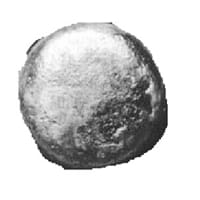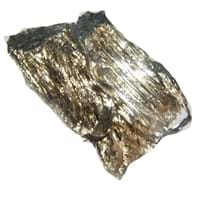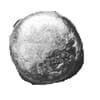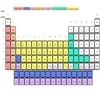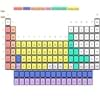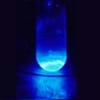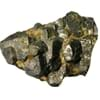Plutonium vs Samarium
Periodic Table
Symbol
Pu
Sm
Group Number
0
18
Not Available
Period Number
7
6
Block
f block
f block
Element Family
Actinide
Lanthanide
CAS Number
7440075
99+
7440199
99+
Space Group Name
P121/m1
R_ 3m
Space Group Number
11.00
13
166.00
6
Facts
Interesting Facts
- Plutonium metal if obtain from ores of uranium metal.
- Plutonium metal is very sensitive to the change in atmospheric conditions like temperature and pressure.
- Samarium metals helps stimulating body metabolism.
- Samarium metals was 1st observed by Jean Charles Galissard de Marignac in Dydimia in 1853.
Sources
Mining, Ores of metals
Found in Minerals, Mining, Ores of Minerals
History
Who Discovered
Glenn T. Seaborg, Arthur Wahl, Joseph W. Kennedy, Edwin McMillan
Lecoq de Boisbaudran
Discovery
In Between 1940 1941
In 1879
Abundance
Abundance In Universe
Not Available
5 * 10-7 %
19
Abundance In Sun
~-9999 %
~0.0000001 %
26
Abundance In Meteorites
Not Available
0.00 %
37
Abundance In Earth's Crust
Not Available
0.00 %
29
Abundance In Oceans
Not Available
0.00 %
40
Uses
Uses & Benefits
- Plutonium was used in atomic bombs and still it is being used in various weapons and Ammunition industry.
- It is also used in nuclear power plant as source of energy for space missions.
- Magnets of Samarium cobalt alloy are stronger than that of Iron and hence, they are used in microwave application.
- Samarium metal also used in optical lasers and infrared absorbing glasses and as a neutron absorber.
Industrial Uses
Aerospace Industry, Ammunition Industry
Aerospace Industry, Automobile Industry, Chemical Industry, Electrical Industry, Electronic Industry
Medical Uses
NA
NA
Other Uses
Alloys
Alloys, In Nuclear Reactors
Biological Properties
Toxicity
Toxic
Slightly Toxic
Present in Human Body
No
Yes
In Blood
0.00 Blood/mg dm-3
37
0.01 Blood/mg dm-3
22
In Bone
0.00 p.p.m.
36
Not Available
Physical Properties
Melting Point
639.50 °C
99+
1,072.00 °C
99+
Boiling Point
3,235.00 °C
24
1,900.00 °C
99+
Appearance
Physical State
Solid
Solid
Color
Silvery White
Silvery White
Luster
NA
Lustrous
Hardness
Brinell Hardness
Not Available
441.00 MPa
27
Vickers Hardness
Not Available
412.00 MPa
24
Speed of Sound
2,260.00 m/s
99+
2,130.00 m/s
99+
Optical Properties
Allotropes
No
No
α Allotropes
Not Available
Not Available
β Allotropes
Not Available
Not Available
γ Allotropes
Not Available
Not Available
Chemical Properties
Chemical Formula
Pu
Sm
Isotopes
Known Isotopes
20
19
30
9
Electronegativity
Pauling Electronegativity
1.28
33
1.17
40
Allred Rochow Electronegativity
1.22
26
1.07
32
Electropositivity
Pauling Electropositivity
2.72
21
2.83
14
Ionization Energies
1st Energy Level
584.70 kJ/mol
99+
544.50 kJ/mol
99+
2nd Energy Level
1,128.00 kJ/mol
99+
1,070.00 kJ/mol
99+
3rd Energy Level
2,084.00 kJ/mol
99+
2,260.00 kJ/mol
99+
4th Energy Level
3,338.00 kJ/mol
99+
3,990.00 kJ/mol
37
Electrochemical Equivalent
2.28 g/amp-hr
22
1.87 g/amp-hr
34
Electron Work Function
Not Available
2.70 eV
99+
Other Chemical Properties
Corrosion, Ionization, Radioactive Isotopes, Radioactivity
Ionization, Radioactive Isotopes
Atomic Properties
Atomic Number
94
24
62
99+
Electron Configuration
[Rn] 5f6 7s2
[Xe] 4f6 6s2
Crystal Structure
Monoclinic (MON)
Rhombohedral (RHO)
Crystal Lattice
MON-Crystal-Structure-of-Plutonium.jpg#100
RHO-Crystal-Structure-of-Samarium.jpg#100
Atom
Number of Protons
94
24
62
99+
Number of Neutrons
150
11
88
39
Number of Electrons
94
24
62
99+
Radius of an Atom
Atomic Radius
159.00 pm
28
180.00 pm
14
Covalent Radius
187.00 pm
20
198.00 pm
13
Van der Waals Radius
200.00 pm
28
229.00 pm
20
Atomic Weight
244.00 amu
19
150.36 amu
99+
Atomic Volume
12.32 cm3/mol
99+
19.95 cm3/mol
19
Adjacent Atomic Numbers
Valence Electron Potential
64.90 (-eV)
21
44.80 (-eV)
37
Lattice Constant
618.30 pm
4
362.10 pm
33
Lattice Angles
NA
π/2, π/2, 2 π/3
Lattice C/A Ratio
Not Available
Not Available
Mechanical Properties
Density
Density At Room Temperature
19.82 g/cm3
13
7.52 g/cm3
99+
Density When Liquid (at m.p.)
16.63 g/cm3
8
7.16 g/cm3
32
Tensile Strength
Not Available
Not Available
Viscosity
Not Available
Not Available
Vapor Pressure
Vapor Pressure at 1000 K
0.00 (Pa)
26
0.94 (Pa)
9
Vapor Pressure at 2000 K
2.20 (Pa)
12
Not Available
Elasticity properties
Shear Modulus
43.00 GPa
18
19.50 GPa
34
Bulk Modulus
Not Available
37.80 GPa
35
Young's Modulus
96.00 GPa
21
49.70 GPa
37
Poisson Ratio
0.21
32
0.27
19
Other Mechanical Properties
Ductile, Malleable
NA
Magnetic Properties
Magnetic Characteristics
Specific Gravity
19.84
7
7.52
99+
Magnetic Ordering
Paramagnetic
Paramagnetic
Electrical Properties
Electrical Property
Poor Conductor
Conductor
Resistivity
1.46 nΩ·m
99+
0.94 nΩ·m
99+
Electrical Conductivity
0.01 106/cm Ω
99+
0.01 106/cm Ω
99+
Electron Affinity
Not Available
50.00 kJ/mol
21
Thermal Properties
Specific Heat
0.13 J/(kg K)
39
0.20 J/(kg K)
31
Molar Heat Capacity
35.50 J/mol·K
3
29.54 J/mol·K
7
Thermal Conductivity
6.74 W/m·K
99+
13.30 W/m·K
99+
Critical Temperature
Not Available
Not Available
Thermal Expansion
46.70 µm/(m·K)
6
12.70 µm/(m·K)
30
Enthalpy
Enthalpy of Vaporization
344.00 kJ/mol
25
166.40 kJ/mol
99+
Enthalpy of Fusion
2.82 kJ/mol
99+
8.62 kJ/mol
40
Enthalpy of Atomization
360.00 kJ/mol
26
209.00 kJ/mol
99+
Standard Molar Entropy
Not Available
69.60 J/mol.K
15
|
||
|
||
|
